Abstract
The Pieniny Klippen Belt (PKB) is located in the suture zone between the Central and Outer (Flysch) Carpathians. Its structure is an effect of prolonged processes of the Cretaceous–Miocene folding, thrusting and uplifting. In this zone, tectonic components of different ages and features, including strike-slip-bounded tectonic blocks, thrust units, as well as toe-thrusts and olistostromes, result in the present-day mélange characteristics of the PKB, where individual tectonic units are difficult to distinguish. In the PKB, both tectonic and sedimentary events triggered the mélange creation. The name “Klippen Belt” is derived from cliffs (German Klippen). These cliffs form harder, more erosion-resistant elements of the mélange, residing within less competent clastic deposits, sandstones, shales and marls that form flysch complexes. The cliffs often represent olistoliths, which glided down from elevated areas to the deeper basinal zones. Two olistostrome belts were distinguished. The older one resulted from subduction of the southern part of the Alpine Tethys, and the younger originated in response to the northward shift of the accretionary wedge. The other cliffs were placed within the surrounding clastic by tectonic deformational processes. The flower structure of the PKB was formed during the collision and strike-slip movement of the lithospheric plates. This structure is limited on both sides by deep-rooted faults. Several evolutionary stages could be distinguished in these areas. The rift-related stage is expressed by the opening of the Alpine Tethys that contains two major basins—Magura and Pieniny (Złatne) basins, separated by Czorsztyn Ridge. The reorganization of the Alpine Tethys basins and the development of the accretionary prism happened during the synorogenic stage. This process was initiated by the movement of the Central Carpathians. Thick flysch sequences with olistostromes were deposited in these basins. The Czorsztyn Ridge was destroyed during the late orogenic stages.
1. Introduction
The Pieniny Klippen Belt (PKB) belongs to the Carpathians that form the 1300 km long mountain arc located in Central Europe [1,2,3,4]. The Carpathians stretch from the Vienna Basin to the Iron Gate on the Danube and are linked with the Alps in the west and with the Balkans in the south (Figure 1). The PKB is located between Central and Outer Carpathians in Austria (Vienna vicinity), Slovakia, Poland and Ukraine, up to northern Romania, constituting the 600 km long suture zone [5] between the ALCAPA (Alpine—Pannonian—Carpathians) and North European Plate [6,7]. The Polish part of the PKB (Figure 2) constitutes its central and northernmost segment. It has been studied by geologist since the XIX century, and several traditional stratigraphic successions were distinguished and named after localities in the Polish PKB mountain ranges.
These successions were distinguished taking into account differences in lithology of the Jurassic (locally Triassic)–Cretaceous (locally Paleogene) rigid competent rocks. These are the exposed morphologically rocky elements forming the klippen and typical elements of the Pieniny landscape. These harder, more erosion-resistant rocky elements protrude from less competent clastic deposits, marls and flysch successions. A complex tectonic arrangement, as well as block-in-matrix structure, can be observed in this area. The Dunajec River Gorge is an important geotouristic attraction in the Pieniny Mts. [8,9]. There, it is possible to observe the PKB tectonics, which are a result of the long geodynamic evolution, involving both thrust and strike-slip processes. Various tectonic and sedimentary components of different ages and nature occur here, resulting in the present-day mélange character [10,11,12]). The term “mélange” was first used by [13] and was reintroduced by [14] as chaotic, block-in-matrix rocks with a disorganized internal structure. The authors of [15] presented an overview of the mélange concept following ideas of both sedimentary and tectonic origin [14,16,17,18,19,20,21,22]. They stated that tectonic, sedimentary, and diapiric processes contributed to the formation of mélanges.
Several different views concerning the PKB mélange culminated in the most recently published discussions [23,24,25,26,27] and references therein, and diverging opinions exist between geologists working in particular sectors of the PKB. The problematic structure of the PKB is still controversial and full of intricacies. The PKB region has an exceptionally complex structure and requires much more research work on its details. The purpose of this work is to present the characteristics of the regional geology of the Polish part of the PKB, in terms of the paleogeography and geodynamic basins evolution and the consequent orogeny. It can serve as a review, helping to disseminate interesting PKB geology, especially olistoliths and mélange among geologists and the general public.
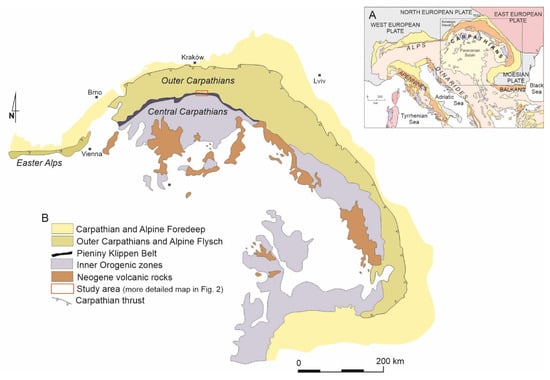
Figure 1.
(A) General tectonic sketch of Carpathians, Alps and adjacent areas with location of (B). (B) Sketch geological map of the Carpathians and adjacent areas with the location of the investigated area (Figure 2). On the basis of [28] Kováč et al., 1998—simplified.
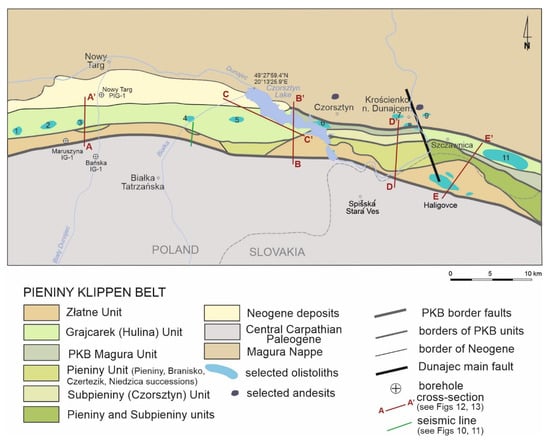
Figure 2.
Sketch map of the Pieniny Klippen Belt in Poland with the location of olistoliths and andesites. Modified from [11]. Selected olistoliths: 1—Stare Bystre, type B; 2—Rogoźnik, type A, C; 3—Szaflary, type C, type C; 4—Kramnica and Obłazowa, type C, 5—Lorencowe Skałki, type B, 6—Czorsztyn, type C, 7—Łupisko, type C, 8—Zawiasy, type B, 9—Ścigocki Stream, type B, 10—Haligovce, type B, C, 11—Homole-Biała Woda, type C. Selected outcrops of andesites: 12—Wżar, 13—Krościenko, 14—Malinowa.
2. Geological Setting and Paleogeography
The PKB marks the suture zone between Central Carpathian and North European plates [3,5], as well as the boundary between Central and Outer Carpathians. The name Pieniny Klippen Belt (pieninische Klippenzug) was first used by [29]. The geographic part of the PKB name is related to the mountain ranges in Poland and adjacent part of Slovakia—Spiskie (Spiš) Pieniny Mts., Pieniny Mts. and Małe (Little) Pieniny Mts. [30]. Another part of this name is derived from the “Klippen”, that are relatively erosion-resistant blocks. These blocks are composed of several successions of mainly deep and shallow-water limestones, covering a time span from the Early Jurassic to the Early Cretaceous [10,31,32,33,34,35]. The traditional successions, Grajcarek (Hulina), Czorsztyn, Niedzica, Czertezik, Branisko, Pieniny, Złatne and Haligovce, e.g., [32,33,36,37,38], crop out in this area and have been formally defined in terms of lithostratigraphy [32]. They are surrounded by mainly turbiditic sandstones and mudstones (flysch), shales and marls.
During the Jurassic and Cretaceous, the sedimentary rocks of the PKB were deposited in the SW–NE oriented paleogeographic realm, known as the Alpine Tethys (Figure 3) that was divided into two basins separated by the Czorsztyn Ridge [32,33,39,40,41], as equivalents of the Briançonnais units of the Western Alps [40]. This ridge emerged during the Early Bajocian time. Some formations were deposited before the origin of the Czorsztyn Ridge, while others were deposited simultaneously with the ridge uplift. The submarine Czorsztyn Ridge and its slopes were characterized by a pelagic type of sedimentation [32,33]. The extremely deep-water pelagic limestones and radiolarites were followed by Albian–Miocene marls and clastic within the basins surrounding the ridge [32,36,39,42,43].
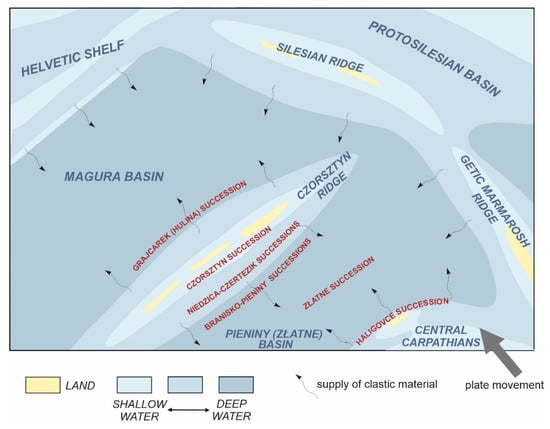
Figure 3.
Paleogeography of Alpine Tethys and adjacent areas during the Albian; plate position at 112 Ma. Modified from [44].
The Miocene subvertical strike-slip fault separates the PKB from the present-day Outer Carpathians (e.g., [45,46,47,48,49]. Several Outer Carpathian nappes and thrust-sheets are thrust by 70 km (distance between the Carpathian front in vicinity of Kraków and PKB in vicinity of Nowy Targ), over the southern part of the North European Plate, between Nowy Targ and Kraków [2,48]. These nappes are built by Upper Jurassic–Lower Miocene, up to six kilometres thick, continuous flysch sequences, mainly deep-water turbidites. The southernmost large Magura Nappe borders the PKB. The Miocene magmatic intrusions cut through the Magura Nappe, forming andesitic dykes and sills distributed along the Pieniny Andesitic Line (PAL) [11,33,34,50,51,52,53]. The crystalline basement of the North European Plate is covered by Paleozoic and Mesozoic rocks and by the autochthonous Miocene deposits, originated in the Carpathian Foredeep. The western part of the PKB in Poland is covered by the Neogene and Quaternary fresh-water deposits of the Orawa-Nowy Targ Basin. Several papers devoted to the PKB discuss the sedimentary mélanges and olistolithic blocks in Poland and Slovakia [54,55,56]. The most recent synthesis [41] suggested that olistostromes in the PKB occur within two belts. The older one resulted from subduction of the southern part of the Alpine Tethys during the Late Cretaceous and was deposited in the Pieniny (Złatne) Basin. The younger olistostromes originated in response to the northward shift of the accretionary wedge in the turn of the Late Cretaceous and Paleogene. They were emplaced within flysch sediments along the southern margin of the Magura Basin.
3. Methods
The present authors carried out literature studies of the most recent publications and archival materials, studies of the existing geological and geophysical maps and profiles, as well as field work. The field geological works included location and documentation of outcrops, lithological and sedimentological logging, stratigraphic observations, sampling and geological mapping. The age of the analysed samples of sedimentary rocks was established on the basis of litho- and biostratigraphy. The final interpretation included analysis of field data, sedimentological and facies characteristics, structural features together with the laboratory results of paleontological, petrographic, geochemical and mineralogical studies. Integration of these results enabled us to reach conclusions on the sedimentary processes, stratigraphic framework, paleogeographic and tectonic evolution of the basins and tectonic units in which the analysed rocks occur.
The geological observations were supplemented by geophysical surveys. Geophysical methods are measurements of physical quantities (impedance, speed of seismic wave propagation, density, electrical resistivity, conductivity, etc.) aimed at identifying comprehensively the rock mass structure and lithology characteristic of the subsurface. In previous works, the authors presented the results of the deep seismic reflection survey that were completed in 2015 (profiles 03-01-15K and 04-01-15K) [3,21,57,58]. In this article, we present preliminary results of the recently conducted seismic refraction tomography (SRT) survey [59] that made it possible to carry out a near surface investigation of the PKB.
4. Results
4.1. Stratigraphy
4.1.1. Basinal Successions
These successions include synrift formations deposited in the Alpine Tethys prior to the emergence of the Czorsztyn Ridge, as well as deposits of the central part of the Pieniny (Złatne) and Magura basins [60,61,62] (Figure 4 and Figure 5).
The spotty marls of the Fleckenkalk/Fleckenmergel facies, Pliensbachian–Toarcian in age (e.g., Szopka Limestone Formation) as well as dark clastic sediments containing organic matter (Figure 6A) of Aalenian–Lower Bajocian deposits (Skrzypny Shale Formation) represent older deposits, while middle–upper Bajocian spotty shales and/or marls (Harcyground Shale Formation and Podzamcze Limestone Formation, respectively) are younger [61,62,63,64]. The Upper Bajocian–Oxfordian sequences are represented by the siliceous rocks (Figure 6B) within the deeper part of the basin. These siliceous deposits include the black manganese cherts (Sokolica Radiolarite Formation), as well as green and red radiolarites (Czajakowa Radiolarite Formation). The siliceous deposits were followed by the Kimmeridgian–Lower Tithonian red nodular limestones (Figure 6C) and marls of the Ammonitico Rosso facies (Czorsztyn Limestone Formation), Tithonian–Lower Cretaceous cherty limestones (Figure 6D) of the Maiolica/Biancone-type (Pieniny Limestone Formation) and Aptian–Albian spotty limestones and marls (Kapuśnica Formation). Locally, the Pieniny Limestone Formation was deposited up to the Albian. These basinal formations belonged to the Branisko, Pieniny and Złatne succession deposited in the central part of the Pieniny (Złatne) Basin, as well as to the Grajcarek (Hulina) Succession deposited in the Magura Basin. These successions are characterized by reduced thickness of extremally condensed deposits. The thickness of the Bajocian–Lower Cretaceous cherts and limestones does not exceed 30 m. The deeper slope equivalents of these deposits, belonging to the Branisko (Kysuca) and Pieniny successions, are significantly thicker. The Pieniny Limestone Formation reaches 200 m constituting the main component of the Pieniny Mts. This is the basis of the Trzy Korony (Figure 6E) and Sokolica Mountains and the cliffs in the scenic Dunajec River gorge (Figure 6F). It also forms the highest peak Wysokie Skałki in the Małe Pieniny Mts. and Branisko Mountain in the Spiskie Pieniny Mts.
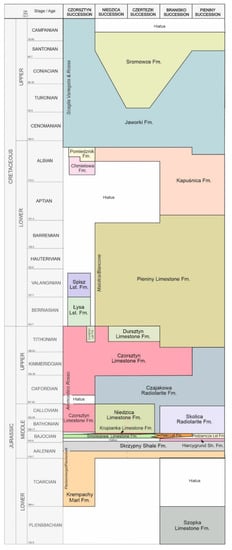
Figure 4.
Lithostratigraphy of the Mesozoic interval of the Czorsztyn, Niedzica, Czertezik, Branisko and Pieniny successions of the Klippen Belt in Poland and bordering part of Slovakia, based on [32,38,60]; time scale according to [65].
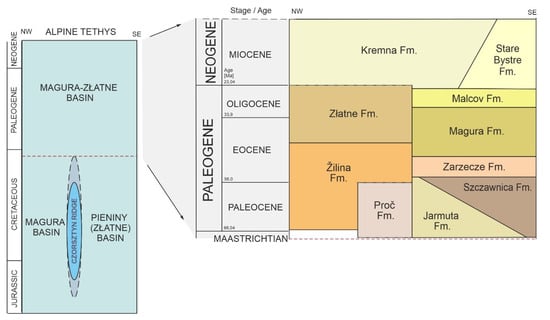
Figure 5.
Lithostratigraphy of the latest Cretaceous–Neogene interval of the Magura-Złatne Basin, based on [11,32]; time scale according to [65].
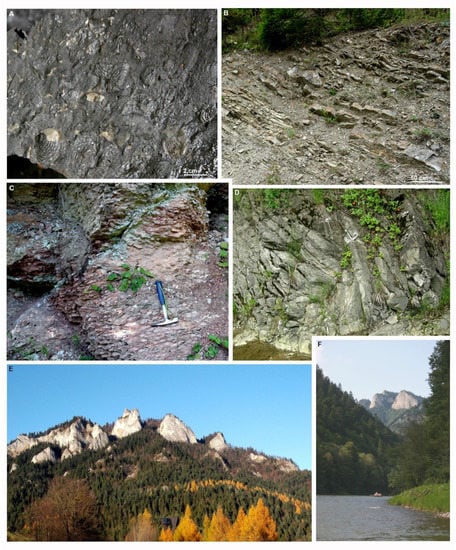
Figure 6.
(A) Dark mudstone with shells of mollusks Bositra sp. Skrzypny Shale Formation. Jaworki, Małe Pieniny Mts. Photo by Michał Krobicki. (B) Cherts (radiolarites) of Sokolica Radiolarite Formation, Branisko Succession. Flaki, Pieniny Mts. (C) Red nodular limestones of Ammonitico Rosso facies. Czorsztyn Limestone Formation. Branisko Succession. Stare Bystre. (D) Maiolica type cherty limestone. Pieniny Limestone Formation. Złatne Succession, Maruszyna, Mały Rogoźnik Stream. (E) Trzy Korony Mountain. Pieniny Mts. (F) Scenic Dunajec River Gorge. Pieniny Mts. Photo by Michał Krobicki.
The deep-water pelagic marls and flysch turbiditic were deposited in the basins during the Albian–Late Cretaceous times. The occurrence of flysch indicates a synorogenic stage of the Alpine Tethys. In the central Pieniny (Złatne) Basin, the Pieniny Limestone Formation is followed by the Albian–Cenomanian flysch of the Trawne Member (Figure 7A) of the Jaworki Formation (Figure 7B), the first, oldest input of clastics within pelagic deposits of variegated marls of the Scaglia Variegata/Rossa-type (Jaworki Formation) [60]. In the Branisko (Kysuca) and Pieniny successions deposited on the deeper slopes, the Pieniny Limestone Formation is followed by the Aptian–Albian dark-grey spotty limestones and marls of the Kapuśnica Formation (Figure 7C). The marls with flysch-type intercalations of the Jaworki Formation are covered by the Upper Cretaceous (Turonian–Santonian) sandy turbiditic siliciclastic flysch deposits (Figure 7D), with exotic-rich conglomerates (Sromowce Formation). The Uppermost Cretaceous and Paleogene are also represented by silicilastic flysch deposits. The Uppermost Cretaceous–Paleocene, mainly coarse clastic rocks of the Proč Formation, are covered by Eocene flysch of the Žilina Formation, Eocene–Oligocene turbidites of the Złatne Formation and Miocene flysch of the Kremna Formation (Figure 7E). These formations also contain intercalations of exotic conglomerates and olistostromes [23,41].
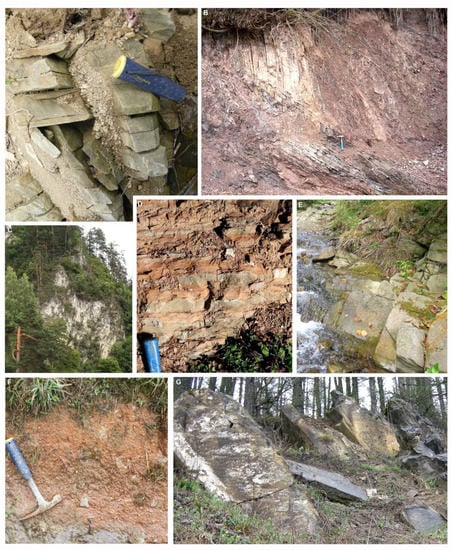
Figure 7.
(A) Flysch of the Trawne Member of the Jaworki Formation. Rogoźnik, Trawne Stream. (B) Red mudstones and marls of the Jaworki Formation Maruszyna, Mały Rogoźnik Stream. (C) Spotty limestones and marls of Kapuśnica Formation. Kapuśnica, Pieniny Mts. (D) Flysch of the Sromowce Formation. Sromowce, Pieniny Mts. (E) Sandstones of the Kremna Formation according to [66]. Jaworki, Zaskalski Stream, Małe Pieniny Mts. (F) Red mudstones of the Malinowa Shale Formation. Krempachy. Spiskie Pieniny Mts. (G) Flysch of the Hałuszowa Formation, Frydman. Spiskie Pieniny Mts.
In the central Magura Basin (Grajcarek/Hulina Succession), the Albian dark-grey siliceous shales, limestones and spotty marlstones of the Kapuśnica Formation are followed by Albian–Cenomanian anoxic blackish turbiditic shales, sandstones and mudstones belonging to the Wronine, Sztolnia and Hulina formations. Variegated, mostly red hemipelagic mudstones (Figure 7F) of the CORB-type (Cretaceous Oceanic Red Beds), with intercalations of thin-bedded turbiditic sandstones of the Malinowa Shale Formation were deposited during Turonian–Campanian [67,68,69]. The green and black bituminous shales, siliceous shales and radiolarites represent the transition between anoxic flysch and red beds. The grey turbidites of the Hałuszowa Formation (Figure 7G) locally replace the upper part of the Malinowa Shale Formation. The Jarmuta Formation (Figure 8A) was deposited during the Maastrichtian–Paleocene. It contains conglomerates with numerous exotic debris-flow olistostromes and calcareous sandy turbidites. The Jarmuta Formation closely resembles the Proč Formation from the Złatne Succession, and the name Jarmuta–Proč Formation is also used. The proximal sandstones of the Jarmuta Formation were replaced in the other part of the Magura Basin, within the PKB, by the distal turbidites of the Paleocene–Lower Eocene Szczawnica Formation [70,71]. The Szczawnica Formation (Figure 8B) covers the Malinowa Formation and locally the Jarmuta Formation. It contains fine-grained sandstones, with characteristic parallel and convolute stratifications, including intercalations of grey or blue-grey mudstones. It also contains coarse-grained calcareous sandstones similar to those known from the Jarmuta Formation. Similar deposits are known outside the PKB as Ropianka or Solan formations [44]. The Szczawnica Formation is covered by the Eocene Zarzecze Formation (Figure 8C) [72], followed by Eocene–Oligocene thick-bedded sandy complexes of the Magura Formation (Figure 8D) [44,70,71,73]. The youngest deposits of the Magura Nappe in the area are represented by the Oligocene–Lower Miocene thin- and medium-bedded sandstone-mudstone turbidites of Malcov Formation [74] and by Miocene flysch of the Kremna and Stare Bystre Formations [66,75,76,77].
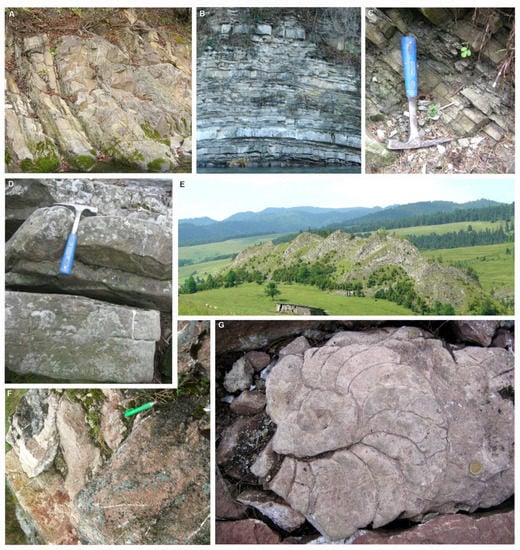
Figure 8.
(A) Flysch of the Jarmuta Formation. Szczawnica-Malinowa, Grajcarek Stream. Małe Pieniny Mts. (B) Flysch of the Szczawnica Formation. Krościenko-Łąkcica. (C) Flysch of the Zarzecze Formation. Szczawnica-Sewerynówka. Zaskalnik Waterfall. (D) Sandstones of the Magura Formation. Szczawnica-Sewerynówka. Zaskalnik Waterfall. (E) White crinoidal limestones of the Smolegowa Limestone Formation. Jaworki-Biała Woda. Smolegowa Skała cliff. Małe Pieniny Mts. (F) Red crinoidal limestone of the Krupianka Limestone Formation. Falsztyn. Spiskie Pieniny Mts. (G) Limestone of the Czorsztyn Limestone Formation (Ammonitico Rosso-type) with ammonite. Jaworki, Małe Pieniny Mts.
The Upper Cretaceous-Neogene sequences of the Pieniny (Złatne) Basin display a sedimentary mélange or wildflysch character. The olistoliths in this wildflysch belong to Triassic–Cretaceous limestones (Figure 9B), as well as Paleocene coral-algal reefal Kambühel limestones (Figure 9B,C) and Eocene nummulitic limestones (Figure 9D).
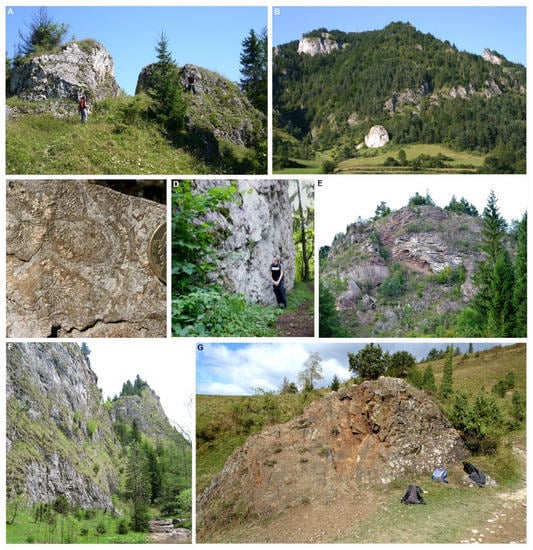
Figure 9.
(A) Rogoźnik coquinas. Rogoźnik. Photo by Michał Krobicki. (B) Haligovce Klippen olistoliths. Paleocene coral-algal reefal Kambühel limestone in the foreground, Triassic-Cretaceous limestones in the background. Haligovce, Małe Pieniny Mts. Photo by Michał Krobicki. (C) Coral-algal reefal Kambühel limestone with corals. Velky Lipnik. Małe Pieniny Mts. Photo by Michał Krobicki. (D) Eocene nummulitic limestone. Aksamitka Mountain. Małe Pieniny Mts. (E) Czajakowa Skała Cliff. Jaworki. Małe Pieniny Mts. (F) Homole-Biała Woda block. Jaworki-Biała Woda. Małe Pieniny Mts. (G) Cretaceous basalt (olistolith). Jaworki-Biała Woda. Małe Pieniny Mts.
4.1.2. Czorsztyn Ridge and Slope Successions
The Czorsztyn Ridge was formed during the early Bajocian times. The sedimentation of the white crinoidal limestones of the Smolegowa Limestone Formation (Figure 8E) started in the late early Bajocian [62]. This formation is followed by red crinoidal limestones of the Krupianka Limestone Formation (Figure 8F), enriched with iron compounds. The crinoidal limestones were accompanied by synsedimentary breccias formed by submarine gravity faults. The red nodular limestones of the Czorsztyn Limestone Formation (Figure 8G) represent Rosso Ammonitico-type sediments. Their sedimentation started in the late Bajocian and lasted until the end of Tithonian. The nodular limestones are covered by the Berriasian pink and white massive calpionellid- and shell-bearing (ammonites and brachiopods within crinoidal debris) limestones of the Dursztyn Limestone Formation and Łysa Limestone Formation, respectively, and are overlaid by Valanginian red crinoidal limestones of the Spisz Limestone Formation. The f Rogoźnik coquinas (Figure 9A) belong both to the uppermost part of the Czorsztyn Limestone Formation and Dursztyn Limestone Formation [32,38,65]. Slope facies are represented by Niedzica and Czertezik successions which form the transitional zone between the shallowest Czorsztyn Succession and basinal one—Branisko and Pieniny successions [32,33,38,78]. The successions originating in the transitional zone have a carbonate-siliceous character formed during the Jurassic time and are represented both by red nodular limestones of Ammonitico Rosso facies (Niedzica and Czorsztyn Limestone Formations; Bajocian-Callovian and Kimmeridgian–Tithonian in age, respectively) intercalated by red-green radiolarites of the Czajakowa Radiolarite Formation; Oxfordian in age presumably originated below the CCD level. These radiolarites are covered by thin Calpionella-bearing limestones (Dursztyn Limestone Formation) with phosphatic structures on the top [79] indicating upwelling currents. These limestones are followed by thin-bedded micritic cherty limestones of Maiolica/Biancone facies (Pieniny Limestone Formation) Berriasian–Barremian. The pelagic Lower and Upper Cretaceous marly-limestone sequences of the Kapuśnica and Jaworki Formations cover carbonate units in the Niedzica, Czertezik and Czorsztyn successions. These marly-limestone sequences are finally covered by turbiditic flysch of the Sromowce Formation, sometimes with gravelstone debris-flow intercalations with exotic pebbles [60,80].
4.1.3. Southern Slope Succession
The Haligovce Succession developed on the basin shoulder and its slope of the southeastern margin of the Pieniny (Złatne) Basin. The rocks belonging to this succession [32,33,81] are known from olistoliths occurring in the mélange in the vicinity of Haligovce village in the southern part of the Małe Pieniny Mts.
The group of huge olistoliths (Figure 9A) known as Haligovce Klippen ([41] and references therein) contains Triassic–Paleogene sedimentary rocks [32,33,34,81,82,83,84,85,86]. The oldest part is represented by Middle Triassic grey, limestones, dolomitic limestones and dolomites. The Younger Jurassic sequence is represented by Lower Jurassic light-grey crinoidal limestones and grey massive organogenic-oolitic limestones, Lower-Middle Jurassic grey sandy-crinoidal limestones with black cherts, Callovian-Oxfordian nodular limestones with rarely cherts, and Kimmeridgian green radiolarian limestones and radiolarites. The younger rocks are represented by Tithonian–Valanginian light-grey limestones with black cherts, Hauterivian–Barremian (Urgon-type) organodetritic, rudist limestones, and Albian sandy phosphatic and glauconitic limestones. Olistoliths also contain Paleocene light grey coral-algal reefal Kambühel limestones, (Figure 9B) and Eocene nummulitic limestones (Figure 9C).
4.2. Pieniny Klippen Belt Mélange
Both tectonic and sedimentary processes contributed to the origin of mélanges in the PKB. The tectonic processes resulted in the creation of a complex structure expressed in the existence of nappes and secondary thrust units, as well as strike-slip faults of different orientation. The mass transportation sedimentary processes produced toe-thrusts and olistostromes. These olistostromes are arranged in two belts related to the Złatne and Grajcarek (Hulina) units [3,5,11,41]. The flysch complexes are main components of these units. The southern belt contains Upper Cretaceous turbidites of the Sromowce Formation, as well as the Paleogene reefal limestones of Kambühel-type contained in the Paleocene–Eocene turbidites of the Žilina Formation [41,55,56,80,86,87]. They were transported from the advancing Central Carpathians towards the Pieniny (Złatne) Basin (Figure 3) in the fore-arc setting [41], resembling recent oceanic margins [88,89,90,91,92,93,94] and references therein. The Pieniny (Złatne) Basin olistoliths represent type A (small blocks in matrix), Figure 9C,B (large blocks in matrix), Figure 9D, C (olistoliths almost without a matrix), and Figure 9B, applying [20] terminology.
The second belt contains olistoliths formed in the Magura Basin [23,41,56]. The Homole-Biała Woda block (Figure 9E) in the vicinity of Jaworki village is one of the largest olistoliths in the Carpathians representing the olisthoplaka sensu [95], and/or the olistoplaques sensu [22]. It is also the prime geotouristic attraction visited by numerous tourists [41,96]. This olistolith consists of Jurassic–Cretaceous sequences of Czorsztyn and Niedzica successions. These rocks originated on the Czorsztyn Ridge and its slope and were later transported into the Magura Basin. The Homole-Biała Woda olistolith is surrounded by the Paleocene strata of the Jarmuta Formation, belonging to the Grajcarek (Hulina) Unit [45,76]. This olistolith displays a complex internal structural relationship between the Czorsztyn and Niedzica successions. The structure of the PKB in this area is also quite complex, involving the thrust of Grajcarek (Hulina) over the Magura PKB Unit, as well as the flower structure of the PKB. It makes the tectonic and sedimentary features of the mélange in this area difficult to unravel. Another olistolith in this belt is represented by basalt (Figure 9F) originating in the Early Cretaceous [97,98] in an ocean island setting [41,68]. This olistolith was transported into the Magura Basin and now is surrounded by turbidites of the Jarmuta Formation. Several olistoliths deposited in the Magura Basin are now located within the turbidites of the Grajcarek (Hulina) Unit and Krynica Unit of Magura Nappe. The olistostromes origin is related to the overriding of the Czorsztyn Ridge by flysch of the advancing accretionary wedge during latest Cretaceous–Paleocene times [41].
4.3. PKB Mélange in the Seismic Image—Preliminary Results of SRT Research
The PKB mélanges are documented based on the surface observations, as well as the geophysical research that makes it possible to interpret the geological structure. To obtain the subsurface image, the seismic refraction tomography (SRT) measurements were carried out within the PKB in the Spiskie Pieniny Mts. region, in the area of single limestone block occurrences, with the most popular being Obłazowa-Kramnica and Lorencowe Skałki (Figure 2), occurring in mild morphology. The seismic profile was normal oriented through a “belt of limestone outcrops” (Figure 10), but there were no limestone outcrops on the profile itself. The SRT profile was 1075 m long, and maximum depth of seismic imaging was 90 m. It covered the PKB structure and surrounding contiguity.
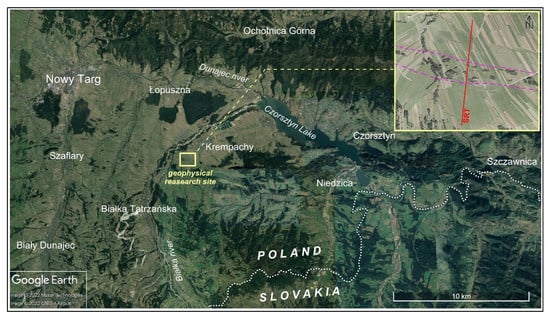
Figure 10.
Location of seismic refraction tomography measurement (SRT)—red line. Dashed magenta line indicates a “belt of limestone outcrops”.
The seismic waves propagate through subsurface media at different speeds depending on the lithology, weathering, fractures, porosity and pore infill, density and other physical properties [99].
The SRT cross section (Figure 11) shows significant horizontal changes of seismic P-wave velocity within the bedrock that reveal the complex geological structure within the area of study. Based on high and nearly vertical velocity contrasts, the seismic cross section can be divided into several zones marked I–X. In general, we can observe four zones of high velocity (stiff rocks) that are embedded with low velocity zones (soft rocks). We can also notice that under those high velocity zones, a portion of the data is trimmed. This is explained by the fact that when a seismic wave travels through an area of high velocity, the wave refracts faster and does not penetrate into deeper parts of the subsurface.
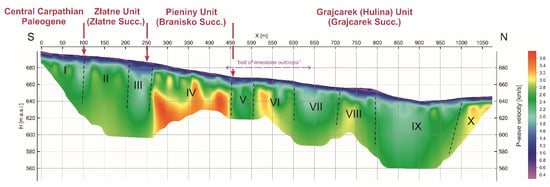
Figure 11.
P-wave velocity model from SRT measurements, with distinguished boundaries between zones with different velocities in the bedrock. They can be interpreted as: I, II, X—sandstone-dominated flysch; III, V, VII, IX—mudstone and marl-dominated flysch; IV, VIII—limestone blocks (VIII—olistolith); VI—mudstone-dominated flysch with olistolith.
Based on the relationship between the type of rock and its seismic velocity [100,101,102,103], as well as the results of geological mapping of the surface in the studied area, is possible to interpret the first 250 m of the profile as a complex consisting of a sandstone-dominated flysch, where areas of low velocity show mudstone strata. This part responds to the deposits of the Central Carpathian Paleogene and the Złatne Unit (I–III) formed from sandstone-dominated flysch deposits. The area between 250 and 450 m with the highest velocity (IV) corresponds to the limestone with a different degree of weathering and/or clay component. The area (VI and VIII), between 450 and 1000 m of the SRT line, shows isolated elements characterizing with high velocity embedded with elements with low velocities (V, VII and IX), This picture can be interpreted as weathered and/or fractured limestones (blocks) surrounded by mudstone- and marl-dominated flysch respectively. The last 75 m of the profile is characterized by high velocity (X). Based on the surface observations, this high velocity complex corresponds with the occurrence of a massive thick-bedded sandstone of the Jarmuta Formation belonging to the Grajcarek Unit.
5. Discussion
The map view (e.g., [3,11,45,46,47,48,49,104,105,106,107,108,109,110,111,112]) of the suture zone between suture zone ALCAPA and North European plates in Poland depicts three major tectonic domains: the Central Carpathians, PKB and Outer Carpathians separated by tectonic boundaries (Figure 1 and Figure 2). The PKB is a complex structure confined by these boundaries. The tectonic elements included in this structure are related to the Alpine Tethys, which reached several hundred kilometres in width, at the end of the Early Cretaceous. The significant reduction of the width of the Alpine Tethys basins happened during the tectonic evolution, and now the PKB structure is three to five kilometres wide.
Alpine Tethys (Figure 3) originated in the Jurassic between the Central Carpathian and North European plates, as an extension of the Central Atlantic Ocean [3]. In the Middle Jurassic (Bajocian), the Czorsztyn Ridge emerged dividing the Alpine Tethys into the southeastern Pieniny (Złatne) Basin and northwestern Magura Basin. The Pieniny (Złatne) Basin deposits are entirely included in the PKB. Only a part of the Magura Basin is incorporated into the PKB. Another part constitutes the Magura Nappe, an important tectonic element of the Outer Carpathians. The incorporated tectonic elements are known as the Grajcarek (Hulina) and PKB Magura units [33,34,36,39,43,44,58,69,113,114,115]. The name Šariš Unit was also used, however, according to [12], the Šariš Zone includes both Grajcarek (Hulina), the Unit of the PKB, as well as a part of the Magura Nappe adjacent to the PKB boundary.
The Jurassic–Early Cretaceous evolution of the Alpine Tethys is characterized by pre-rift and syn-rift processes. The subduction developed along the northwestern margin of the Central Carpathian Plate, causing its northwestern movement that started in the Albian (Figure 3). The accretionary wedge developed in front of the Central Carpathian Plate within the Pieniny (Złatne) Basin. The turbiditic sequences were deposited in this basin. These sequences include huge olistostromes. The syn-rift regime changed into a synorogenic one. The northwestern movement of the Central Carpathian Plate continued during the Late Cretaceous, until the accretionary wedge reached the slopes of the Czorsztyn Ridge. The collision of wedge and ridge caused the deformation of the slope and ridge deposits. The Pieniny, Branisko, Czertezik, Niedzica, and Czorsztyn sedimentary successions were turned into thrust sheets [32,33,116,117] distinguished between the two main tectonic units that included these thrust sheets. We agree with this scheme (Figure 2, Figure 10 and Figure 11). The Pieniny Unit (nappe) includes the Pieniny and Branisko subunits, while the Subpieniny Unit includes the Czertezik, Nirzica and Czorsztyn subunits. Further movement northwest of the accretionary prism, during the latest Cretaceous–Paleocene times caused further deformation and partial destruction of these Pieniny and Subpieniny units, as well as reorganization of the deposits of the Pieniny (Złatne) Basin. The accretionary prism was transformed into the Złatne Unit (nappe) and overrode the Czorsztyn Ridge. The Pieniny and Subpieniny units were buried under the prism, partially preserved in front of the Złatne Unit or transported as olistoliths into the Magura Basin. Locally, the large olistoliths retained the original thrusts sheet structure. Such a structure is visible in the Homole block in the Małe Pieniny Mts. The Niedzica Subunit is thrust over the Czorsztyn Subunit, forming the scenic Czajakowa Skała cliff (Figure 9D). The Czorsztyn Ridge was destroyed during the latest Cretaceous–Paleocene times, and the accretionary prism of the Złatne Unit reached the margin of the Magura Basin. One Outer Central Carpathian accretionary prism developed in front of the Central Carpathian plate. The turbiditic and pelagic sedimentation continued in the piggy-back setting until Neogene times. Interaction between the Central Carpathian and North European plates caused uprooting of the accretionary prism. The system of nappes was thrust over the North European platform forming the Outer Carpathian orogen. The basement of the Central Carpathian Plate was also thrust over this platform. The Central Carpathian Plate was affected by rotational movement during Neogene times [7,44,118,119,120,121]. The transpressional, transtensional and translational tectonic processes created several faults and caused deformation of the previously created nappes. The Polish PKB obtained its present-day W–E orientation as a result of these processes during the Neogene times (Figure 1 and Figure 2). The Pieniny and Subpieniny units, previously buried under the accretionary prism, were pushed up, protruding between the Złatne and Grajcarek (Hulina) units, and forming the subvertical structure of the Pieniny Mts. between Czorsztyn and Krościenko. The PKB obtained its recent flower structure. Boundaries of the PKB are related to this structure (Figure 2 and Figure 12).
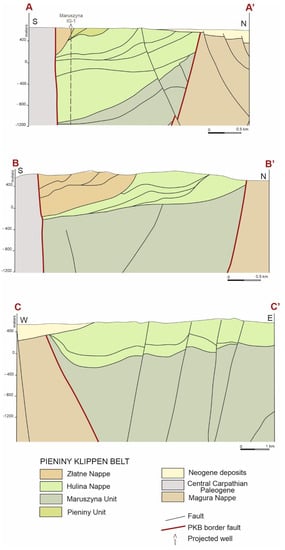
Figure 12.
Cross-sections A—A’. B—B’ and C—C’ through the western part of PKB in Poland. Location of all subfigures in Figure 2. Legend common for all subfigures.
The subvertical fault dipping north represents the southern boundary of PKB [3,5,87]. The northern boundary is represented by a system of south dipping faults. This boundary is not very distinctive; therefore, the authors of [99] depicted the above-mentioned Šariš Zone between the PKB and the Magura Nappe. The PKB structure in Poland can be divided into three different segments, roughly related to the mountain ranges. The western segment includes the Spiskie (Spiš) Pieniny Mts. Its western and central part are characterized by the existence of large tectonic units [3]. The southern Złatne Unit is thrust over the northern Grajcarek (Hulina) Unit. This unit contains mainly Upper Cretaceous and Paleogene flysch sequences. Several secondary thrust sheets were distinguished in both units (Figure 12, Figure 13, Figure 14, Figure 15 and Figure 16). Cross-section A–A’ in Figure 12 is based on seismic profile 24-5-87K and the Maruszyna IG-1 borehole (Figure 13 and Figure 14). Geological interpretation of seismic profiles requires borehole data tied through the synthetic seismograms to the acquired and processed seismic data. This procedure allows for correlation of geological boundaries identified in a borehole with specific seismic reflections on the seismic section.
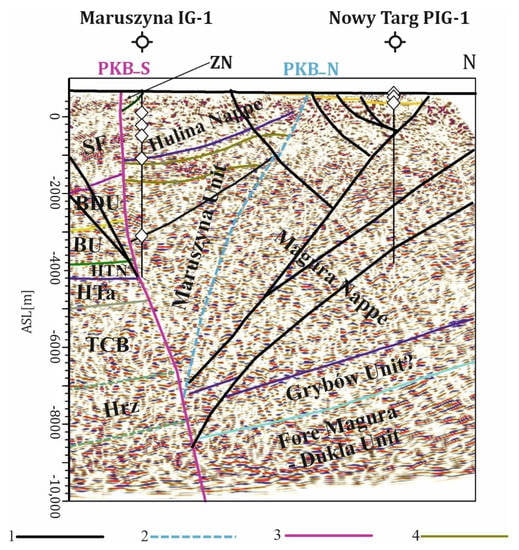
Figure 13.
Profile 24—5—87K—seismic depth section. 1—fault or secondary thrust, 2—north PKB fault, 3—south PKB fault, 4—secondary fold within Maruszyna Unit. Abbreviations: ZN—Złatne Nape, SF—Szaflary Formation, BDU—Biały Dunajec Unit, BU—Bańska Unit, HTN—High Tatric Nappe, HTa—High Tatric autochtonous, TCB—Tatric Crystalline Basement, Hrz—High reflections zone.
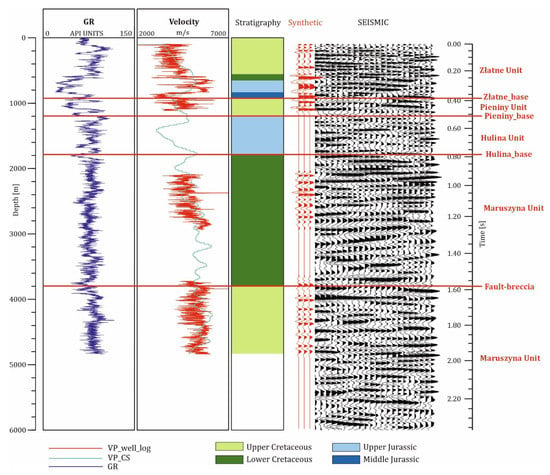
Figure 14.
Synthetic log of borehole Maruszyna IG-1 and seismic correlation. GR—gamma ray, VP_CS—interval velocities from check shot, VP_well_log—interval velocities acoustic log.
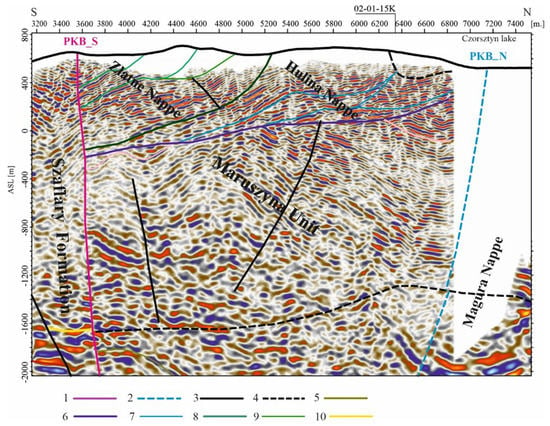
Figure 15.
Shallow part of the seismic profile 04—01—15K. 1—south PKB fault, 2—north PKB fault, 3—fault or secondary thrust, 4—intersection of N-S direction fault, 5—secondary fold within Maruszyna, 6—Hulina Nappe thrust, 7—Secondary thrust within Hulina Nappe, 8—Złatne Nappe thrust, 9—Secondary thrust within Złatne Nappe, 10—bottom of Szaflary Formation (high-amplitude horizon).
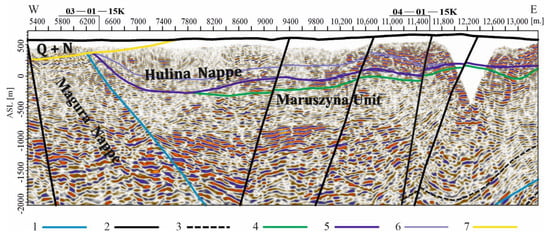
Figure 16.
Shallow part of the seismic profile 02—01—15K. 1—north PKB fault, 2—fault or secondary thrust, 3—fault plane intersection, 4—secondary fold within Maruszyna Unit, 5—Hulina Nappe thrust, 6—Secondary thrust within Hulina Nappe, 7—Quaternary and Neogene (Q + N) base.
The Maruszyna IG-1 borehole (Figure 14) [3,5,122], which penetrates the PKB, was used for the correlation of seismic horizons on lines 24—5—87K. The Maruszyna IG-1 borehole was projected on line 24—5—87K (Figure 13). The geological profile and calculated synthetic seismogram (Figure 14) allowed the authors to identify, in particular, the base of the Złatne Nappe, sliver of Pieniny Unit, base of the Hulina Nappe and the Marudzyna Unit in the seismic profile. The Nowy Targ PIG-1 borehole is the only borehole located on the northern side of the PKB (Outer Carpathians) and provided the only geological profile [123], which was used to correlate seismic horizons on profile 24—5—87K (Figure 13).
Locally, small slivers of the Pieniny Unit containing Jurassic–Lower Cretaceous sequences are visible between two flysch units. The large Pieniny Unit containing mainly the Branisko Succession is exposed in the central Spiskie (Spiš) Pieniny Mts. around the Branisko Mountain. The seismic profiles 03—01—15K and 02—01—15K (Figure 15 and Figure 16) also revealed the existence of the Maruszyna Unit sensu [58] that was encountered in the Maruszyna IG-1 borehole l (Figure 13 and Figure 14). This unit shows the reflection patterns resembling the flysch of the Magura Nappe outside the PKB limits. Cross-section B-B’ in Figure 12 is based on seismic profile 04—01—15K (Figure 15), while cross-section C-C’ is based on seismic profile 02—01—15K (Figure 16).
The eastern segment (Małe Pieniny Mts.) shows a structural arrangement similar to the western one. The large Złatne Unit is thrust over the combined Subpieniny, Pieniny units that are thrust over the Grajcarek (Hulina) Unit (Figure 17). The PKB Magura Unit is exposed on the surface. In the central segment, the subvertical Pieniny Unit was originally thrust over the Subpieniny Unit, that, in turn, is thrust over the narrow Grajcarek (Hulina) Unit. The Subpieniny Unit is composed of several mixed scales of the Niedzica, Czertezik and Czorsztyn subunits.
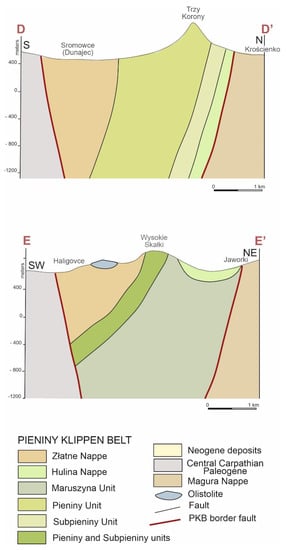
Figure 17.
Cross-sections sections D—D’ and E—E’ through the eastern part of PKB in Poland. Location of all subfigures in Figure 2. Legend common for all subfigures.
The description of the Jurassic and Cretaceous PKB formations was based on the formal lithostratigraphy proposed by [32]. The type areas are located in Poland, but this lithostratigraphy was also generally accepted in Slovakia, e.g., [124]. The minor differences concern mainly the rank of divisions. For example, the Slovakian Snežnica Formation [124] was distinguished by [32] as a Snežnica member within the Sromowce Formation. The originally distinguished time span of [32] formations was slightly modified later, e.g., [11,38,78]. Several stratigraphic issues are still waiting for refinement, especially within the Cretaceous–Neogene basinal successions, see reviews in [12,124,125]. The first issue is the age of the so-called “black flysch deposits” within the Grajcarek Succession. These black turbiditic deposits, belonging to the Albian–Cenomanian Wronine, Sztolnia and Hulina formations, are located between the Cretaceous Kapuśnica and Malinowa formations in the Małe Pieniny Mts. [66,126]. Similar deposits were described as the Toarcian–Bajocian Szlachtowa Formation (see [69] and references therein), being the oldest deposits of the Grajcarek (Hulina) Succession. We assume that black flysch was deposited both in Jurassic and Cretaceous times. The first issue concerns the Neogene Kremna Formation defined by [66,127] mapped large areas in the Małe Pieniny Mts. as the Kremna Formation on the base of nannoplankton studies. This point of view was questioned by [126,128,129] based on forams and dinocysts. We assume that the Neogene Kremna exists in the analysed area together with the other Paleogene formations. The maps made by [66,126] are ambiguous. The maps depict the Kremna Formation, while the documenting photos in [66] display and describe the Magura Formation from the same area. The map depicts the Kremna Formation in the eastern part and Szczawnica and Zarzecze formations in the corresponding western part. These two parts are separated by a fault (Figure 2). These observations require further research.
The names of paleogeographic and tectonic units were used according to priority of their definition. Therefore, we prefer the older names Złatne (Pieniny) and Grajcarek (Hulina), honouring both [32,33,36,37]. The Slovak equivalent of Złatne (Pieniny) is Vahicum and Oravicum introduced later by [130,131]. The Slovak equivalent of Grajcarek (Hulina) is Šariš [12,124,132].
The flower structure of the PKB that shows transpressionally and transtensionaly originated faults was also observed in the eastern PKB in Slovakia [54,133,134]. The dextral strike-slip faults are also visible in Western Slovakia [135]. The dextral shearing occurred between North European and Central Carpathians plates in the Neogene.
The term “mélange” has been used for the PKB by [41], replacing the term megabreccia of [33], and focused instead on the sedimentary mélanges or olistostromes. The block-in-matrix mélange was formed by sedimentary, tectonic and diapiric processes during a long and complex deformational evolution of the PKB structure. The geophysical shallow imaging combined (Figure 13) with geological research allows one to achieve a better picture of tectonic and sedimentary elements of the PKB mélanges. The results obtained by the SRT profiles can be interpreted as follows: several nearly vertical zones can be distinguished.
Zone I represents flysch sequences of the Central Carpathian Paleogene. Zones II-III represent flysch sequences of the Złatne Unit. Boundary between I and II zones represents the southern limit (fault) of the PKB. Flysch sequences of the Central Carpathian Paleogene are arranged vertically near this limit, while they dip gently in the area a few kilometres south of the PKB (Golonka et al., 2019). Zone IV represents the Jurassic and Cretaceous, mainly carbonate sequences of the Branisko Succession of the Pieniny Unit. The tectonic sliver of this unit (not cropping out on the surface) is defined by the comparison with the outcrops of this unit in the Małe Pieniny Mts. The type area of the Branisko Succession is located in the nearby Branisko Mountain [32]. Zones V-X represent the Grajcarek (Hulina) Unit, containing Cretaceous–Paleocene flysch and hemipelagic sequences of the Jarmuta and Malinowa formations with olistoliths. Zones VI and VIII represent olistoliths, mainly carbonates belonging to the Jurassic–Cretaceous of the Czorsztyn Succession. Zone X represents thick-bedded sandstone of the Jarmuta Formation.
The block-in-matrix flysch with olistoliths represents the sedimentary mélange. The thrusts of Złatne, Pieniny and Grajcarek (Hulina) units represent the tectonic mélange. The original thrust (nappe) structure was deformed by strike-slip transpressional processes leading to the vertical arrangement of rocks. The diapiric mélange of the Pieniny Mts. is related to this process. The geophysical imaging can help one distinguish tectonic mélanges related to thrusting and developed in fault or shear zones, as well as mass transport complexes. It also allows one to distinguish olistostromes and other mass transport complexes, heavily overprinted by tectonic deformation. A particular field measurement alone often cannot be associated with a unique model of subsurface conditions,= because there is an inherent ambiguity in all geophysical measurements. This ambiguity can be reduced by the use of multiple geophysical methods compared with additional geological information obtained in nearby outcrops. As field work is still ongoing, the seismic measurements will be supplemented with electrical resistivity tomography (e.g., [136,137,138,139]) and gravimetric methods [130], which we hope will reduce the ambiguity of the subsurface geological model of the PKB.
6. Conclusions
The Polish PKB represents a complex geological structure belonging to the suture zone between the Central Carpathian and North European plates. The Mesozoic sedimentary sequences were deposited in the Alpine Tethys oceanic domain originating in the Early Jurassic. This domain was divided into the Pieniny (Złatne) and Magura Basins separated by the Czorsztyn Ridge in the Middle Jurassic. The PKB sedimentary formation was arranged into several successions, according to their position in the basins or on the ridge.
The present-day tectonic structure is a result of the Albian–Neogene geodynamic evolution. The accretionary prism that originated in the Albian and moved continuously during the Late Cretaceous–Paleogene times, overrode and destroyed the Czorsztyn Ridge. The thick flysch sequences belonging to this prism contain numerous olistoliths. These flysch sequences form three tectonic units thrust over each other.
The central part of the Polish PKB (Pieniny Mts.) contains Mesozoic, mainly carbonate sequences, arranged into Pieniny and Subpieniny units originated as thrust sheets and rearranged during the Neogene transpressional, transtensional and translational tectonic processes, related to the strike-slip faults.
The mélange characteristics of the PKB are a result of the Cretaceous–Miocene folding, moving and uplifting processes that created a mixture of strike-slip-bounded tectonic blocks, thrust units, as well as toe-thrusts and olistostromes. Both tectonic and sedimentary events contributed to the creation of this mélange.
Author Contributions
J.G.: draft preparation and editing, A.W.: fieldwork and sampling, stratigraphic work, writing—original draft preparation and editing. K.C.: geophysical fieldwork, writing—original draft preparation and editing. J.D.: geophysical fieldwork, writing—original draft preparation and editing, K.P.: conceptualization. M.Ł.: geophysical fieldwork, project administration. G.B.: geophysical fieldwork, editing. W.J.M.: geophysical fieldwork. S.P.: geophysical fieldwork. All authors have read and agreed to the published version of the manuscript.
Funding
This research was financially supported by the Polish National Science Center grant NCN—2019/35/B/ST10/00241 and by the AGH University of Science and Technology subsidy funds no. 16.16.140.315.
Data Availability Statement
Not applicable.
Acknowledgments
We are grateful to the reviewers. Their remarks helped to significantly improve the paper.
Conflicts of Interest
The authors declare no conflict of interest. The funders had no role in the design of the study; in the collection, analyses, or interpretation of data; in the writing of the manuscript; or in the decision to publish the results.
References
- Książkiewicz, M. Karpaty. In Budowa Geologiczna Polski, T. 4. Tektonika, Cz. 3; Pożaryski, W., Ed.; Wydawnictwa Geologiczne: Warszawa, Poland, 1972; pp. 1–282. [Google Scholar]
- Książkiewicz, M. Tectonics of the Carpathians. In Geology of Poland. Vol. IV. Tectonics; Pożaryski, W., Ed.; Wydawnictwa Geologiczne: Warszawa, Poland, 1977; pp. 476–604. [Google Scholar]
- Golonka, J.; Pietsch, K.; Marzec, P.; Kasperska, M.; Dec, J.; Cichostępski, K.; Lasocki, S. Deep structure of the Pieniny Klippen Belt in Poland. Swiss J. Geosci. 2019, 112, 475–506. [Google Scholar] [CrossRef]
- Golonka, J.; Gawęda, A.; Waśkowska, A. Carpathians. In Encyclopedia of Geology, 2nd ed.; Alderon, D., Elias, S.A., Eds.; Elsevier: Amsterdam, The Netherlands, 2021; pp. 372–381. [Google Scholar] [CrossRef]
- Golonka, J.; Pietsch, K.; Marzec, P. The North European Platform suture zone in Poland. Geol. Geophys. Environ. 2018, 44, 5–16. [Google Scholar] [CrossRef]
- Csontos, L.; Nagymarosy, A.; Horvat, F.; Kováč, M. Tertiary evolution of the Intra-Carpathian area: A model. Tectonophysics 1992, 208, 221–241. [Google Scholar] [CrossRef]
- Csontos, L.; Vörös, A. Mesozoic plate tectonic reconstruction of the Carpathian region. Palaeogeogr Palaeoclimatol. Palaeoecol. 2004, 210, 1–56. [Google Scholar] [CrossRef]
- Birkenmajer, K. Przełom Dunajca w Pieninach—fenomen geologiczny. Pienin. Przyr. I Człowiek 2006, 9, 9–22, (in Polish with English summary). [Google Scholar]
- Golonka, J.; Krobicki, M. Dunajec River rafting as one of the most important geotouristic object of the future trans-bordering PIENINY Geopark. Geotourism 2007, 3, 29–44. [Google Scholar]
- Wierzbowski, A.; Aubrecht, R.; Golonka, J.; Gutowski, J.; Krobicki, M.; Matyja, B.A.; Pieńkowski, G.; Uchman, A. Jurassic of Poland and adjacent Slovakian Carpathians. Field trip guidebook. In Proceedings of the 7th International Congress on the Jurassic System, Kraków, Poland, 6–18 September 2006; pp. 3–235. [Google Scholar]
- Golonka, J.; Krobicki, M.; Waśkowska, A. The Pieniny Klippen Belt in Poland. Geol. Geophys. Environ. 2018, 44, 111–125. [Google Scholar] [CrossRef]
- Jurewicz, E. The Šariš Transitional Zone, revealing interactions between Pieniny Klippen Belt, Outer Carpathians and European platform. Swiss J. Geosci. 2018, 111, 245–267. [Google Scholar] [CrossRef]
- Greenly, E. The Geology of Anglesey: Memoirs of Geological Survey; HM Stationary Office: London, UK, 1919; Volumes I and II, pp. 1–388. [Google Scholar]
- Hsü, K.J. Principles of mélanges and their bearing on the Franciscan-Knoxville paradox. Geol. Soc. Am. Bull. 1968, 79, 1063–1074. [Google Scholar] [CrossRef]
- Festa, A.; Dilek, Y.; Pini, G.; Codegone, G.; Ogata, K. Mechanisms and processes of stratal disruption and mixing in the development of mélanges and broken formations: Redefining and classifying mélanges. Tectonophysics 2012, 568, 7–24. [Google Scholar] [CrossRef]
- Hsü, K.J. Mélanges and their distinction from olistostrome. Spec. Publ. Soc. Econ. Paleontol. Mineral. Tulsa 1974, 19, 321–333. [Google Scholar]
- Abbate, E.; Bortolotti, V.; Passerini, P. Olistostromes and olistolites. Sediment. Geol. 1970, 4, 521–557. [Google Scholar] [CrossRef]
- Elter, P.; Trevisan, L. Olistostromes and the tectonic evolution of the Northern Apennines. In Gravity and Tectonics; de Jong, A.K., Scholten, R., Eds.; John Wiley: New York, NY, USA, 1973; pp. 175–188. [Google Scholar]
- Naylor, M.A. Debris flow (olistostromes) and slumping on a distal passive continental margin: The Palombini limestone-shale sequence of the northern Apennines. Sedimentology 1981, 28, 837–852. [Google Scholar] [CrossRef]
- Pini, G.A. Tectonosomes and olistostromes in the Argille Scagliose of the Northern Apennines, Italy. Geol. Soc. Am. Spec. Pap. 1999, 335, 1–73. [Google Scholar]
- Trümpy, R. Geologie der Iberger Klippen und ihrer Flysch-Unterlage. Eclogae Geol. Helv. 2006, 99, 79–121. [Google Scholar] [CrossRef]
- Camerlenghi, A.; Pini, G.A. Mud volcanoes, olistostromes and Argille scagliose in the Mediterranean region. Sedimentology 2009, 56, 319–365. [Google Scholar] [CrossRef]
- Golonka, J.; Krobicki, M.; Waśkowska, A.; Cieszkowski, M.; Ślączka, A. Reply. Discussion of ‘Olistostromes of the Pieniny Klippen Belt, Northern Carpathians’. Geol. Mag. 2017, 154, 193–200. [Google Scholar] [CrossRef]
- Plašienka, D.; Michalík, J.; Soták, J.; Aubrech, R. Discussion of “Olistostromes of the Pieniny Klippen Belt, Northern Carpathians”. Geol. Mag. 2017, 154, 187–192. [Google Scholar] [CrossRef]
- Jankowski, L. Od podnóża Tatr po brzeg Karpat, Współczesne wyzwania kartografii geologicznej. In Warsztaty terenowe, Konferencja naukowo-szkoleniowa, Kraków/Szczawnica, 17-20.09.2019; Państwowy Instytut Geologiczny—Państwowy Instytut Badawczy: Warsaw, Poland, 2019; (In Polish only). [Google Scholar]
- Jurewicz, E.; Segit, T.; Plašienka, D.; Chrapkiewicz, K. Seismic imaging of mélanges—Pieniny Klippen Belt case study. Discussion. J. Geol. Soc. 2021, 178, 629–646. [Google Scholar] [CrossRef]
- Marzec, P.; Golonka, J.; Pietsch, K.; Kasperska, M.; Dec, J.; Cichostępski, K.; Lasocki, S. Reply to Discussion of ‘Seismic imaging of mélanges; Pieniny Klippen Belt case study’. J. Geol. Soc. 2021, 178, 2020–2111. [Google Scholar] [CrossRef]
- Kováč, M.; Nagymarosy, A.; Oszczypko, N.; Ślączka, A.; Csontos, L.; Marunteanu, M.; Matenco, L.; Márton, M. Palinspastic reconstruction of the Carpathian-Pannonian region during the Miocene. In Geodynamic Development of the Western Carpathians. Geological Survey of Slovac Republic; Rakús, M., Ed.; Dionýz Štúr Publishers: Bratislava, Slovakia, 1998; pp. 189–217. [Google Scholar]
- Neumayr, M. Jurastudien. Der penninische Klippenzug. Jahrb. Geolog. Reichsan. 1871, 21, 451–536. [Google Scholar]
- Kondracki, J. Geografia Regionalna Polski; Polish Science Press: Warsaw, Poland, 2001; pp. 1–446. [Google Scholar]
- Andrusov, D. Geologie der Tschechoslowakischen Karpaten; Berlin Akademie-Verl.: Berlin, Germany, 1965; pp. 1–443. [Google Scholar]
- Birkenmajer, K. Jurassic and Cretaceous lithostratigraphic units of the Pieniny Klippen Belt, Carpathians, Poland. Stud. Geol. Pol. 1977, 45, 1–158. [Google Scholar]
- Birkenmajer, K. Stages of structural evolution of the Pieniny Klippen Belt, Carpathians. Stud. Geol. Pol. 1986, 88, 7–32. [Google Scholar]
- Birkenmajer, K. Exotic Andrusov Ridge: Its role in plate-tectonic evolution of the West Carpathian Foldbelt. Stud. Geol. Pol. 1988, 91, 7–37. [Google Scholar]
- Mišík, M. The Czorsztyn submarine ridge (Jurassic-Lower Cretaceous, Pieniny Klippen Belt): An example of a pelagic swell. Mitt. Der Sterreichische Geol. Ges. 1994, 86, 133–140. [Google Scholar]
- Sikora, W. New data on the geology of the Pieniny Klippen Belt. Bull. Pol. Acad. Sci. Earth Sci. 1962, 10, 203–211. [Google Scholar]
- Sikora, W. Esquisse de la tectogénèse de la zone des Klippes des Pieniny en Pologne d’après de nouvelles données géolgiques. Rocz. Pol. Tow. Geol. 1971, 4, 221–239. [Google Scholar]
- Wierzbowski, A.; Aubrecht, R.; Krobicki, M.; Matyja, B.A.; Schlögl, J. Stratigraphy and palaeogeographic position of the Jurassic Czertezik Succession, Pieniny Klippen Belt (Western Carpathians) of Poland and Eastern Slovakia. Ann. Soc. Geol. Pol. 2004, 74, 237–256. [Google Scholar]
- Golonka, J.; Krobicki, M. Jurassic paleogeography of the Pieniny and Outer Carpathian basins. Riv. Ital. Paleont. Stratig. 2004, 110, 5–14. [Google Scholar]
- Schmid, S.M.; Bernoulli, D.; Fugenschuh, B.; Matenco, L.; Schefer, S.; Schuster, R.; Tischler, M.; Ustaszewski, K. The Alpine–Carpathian–Dinaridic orogenic system: Correlation and evolution of tectonic units. Swiss Jour. Geosc. 2008, 101, 139–183. [Google Scholar] [CrossRef]
- Golonka, J.; Krobicki, M.; Waśkowska, A.; Cieszkowski, M.; Ślączka, A. Olistostromes of the Pieniny Klippen Belt, Northern Carpathians. Geol. Mag. 2015, 152, 269–286. [Google Scholar] [CrossRef]
- Sikora, W. The Pieniny Klippen Belt (Polish Carpathians). In Tectonics of the Carpathian-Balkan Regions; Mahel, M., Ed.; Geological Institute of D. Štur.: Bratislava, Slovakia, 1974; pp. 177–180. [Google Scholar]
- Oszczypko, N.; Ślączka, A.; Oszczypko–Clowes, A.; Olszewska, B. Where was the Magura Ocean. Acta Geol. Pol. 2015, 65, 319–344. [Google Scholar] [CrossRef]
- Golonka, J.; Waśkowska, A.; Ślączka, A. The Western Outer Carpathians: Origin and evolution. Z. Der Dtsch. Ges. Für Geowiss. 2019, 170, 229–254. [Google Scholar] [CrossRef]
- Watycha, L. Szczegółowa Mapa Geologiczna Polski 1:50.000. (bez utworów Czwartorzędowych). Rejon Karpat i Przedgórza. Arkusz Krościenko; Wydawnictwa Geologiczne: Warszawa, Poland, 1964. (In Polish) [Google Scholar]
- Watycha, L. Szczegółowa Mapa Geologiczna Polski 1:50.000. (bez utworów Czwartorzędowych). Rejon Karpat i Przedgórza. Arkusz Nowy Targ; Wydawnictwa Geologiczne: Warszawa, Poland, 1964. (In Polish) [Google Scholar]
- Watycha, L. Szczegółowa Mapa Geologiczna Polski 1:50 000, Arkusz Nowy Targ; Wydawnictwa Geologiczne: Warszawa, Poland, 1975. (In Polish) [Google Scholar]
- Sikora, W.; Borysławski, A.; Cieszkowski, M.; Gucik, S.; Jasionowicz, J. Geological Cross-Section Cracow-Zakopane; Wydawnictwa Geologiczne: Warszawa, Poland, 1980. (In Polish) [Google Scholar]
- Kulka, A.; Rączkowski, W.; Żytko, K.; Paul, Z. Szczegółowa Mapa Geologiczna Polski. 1:50.000. Arkusz Szczawnica-Krościenko. Detailed Geological Map of Poland, Szczawnica-Krościenko Sheet; Wydawnictwa Geologiczne: Warszawa, Poland, 1985. (In Polish) [Google Scholar]
- Birkenmajer, K.; Pécskay, Z. K-Ar dating of the Miocene andesite intrusions, Pieniny Mts. Bull. Pol. Acad. Sci. Earth Sci. 1999, 47, 155–169. [Google Scholar]
- Jurewicz, E.; Nejbert, K. Geotectonic position of the so-called “Pieniny Mts. andesites”. Mineral. Soc. Pol. Spec. Pap. 2005, 25, 179–183. [Google Scholar]
- Nejbert, K.; Jurewicz, E.; Macdonald, R. Potassium-rich rocks in the Western Outer Carpathians: Magmagenesis in transitional zone between European Plate and the Carpathian-Pannonian regions. Lithos 2012, 146–147, 34–47. [Google Scholar] [CrossRef]
- Anczkiewicz, A.A.; Anczkiewicz, R. U–Pb zircon geochronology and anomalous Sr–Nd–Hf isotope systematics of late orogenic andesites: Pieniny Klippen Belt, Western Carpathians, South Poland. Chem. Geol. 2016, 427, 1–16. [Google Scholar] [CrossRef]
- Nemčok, M.; Nemčok, J. Late Cretaceous deformation of the Pieniny Klippen Belt, West Carpathians. Tectonophysics 1994, 239, 81–109. [Google Scholar] [CrossRef]
- Krobicki, M.; Golonka, J.; Kołodziej, B.; Olszewska, B.; Oszczypko, N.; Słomka, T.; Tragelehn, H.; Wieczorek, J. Paleoceńskie olistolity wapieni koralowo-glonowych rejonu Haligowiec (pieniński pas skałkowy, Słowacja). In Egzotyki Karpackie—Znaczenie W Rekonstrukcjach Paleogeograficzno-Geotektonicznych; Krobicki, M., Ed.; Ogólnopolskie Seminarium: Kraków, Poland, 2004; pp. 53–55, (In Polish only). [Google Scholar]
- Cieszkowski, M.; Golonka, J.; Krobicki, M.; Ślączka, A.; Oszczypko, N.; Waśkowska, A.; Wendorff, M. The Northern Carpathians plate tectonic evolutionary stages and origin of olistoliths and olistostromes. Geod. Acta 2009, 22, 101–126. [Google Scholar] [CrossRef]
- Białoń, W.; Lizurek, G.; Dec, J.; Cichostępski, K.; Pietsch, K. Relocation of Seismic Events and Validation of Moment Tensor Inversion for SENTINELS Local Seismic Network. Pure Appl. Geophys. 2019, 176, 4701–4728. [Google Scholar] [CrossRef]
- Marzec, P.; Golonka, J.; Pietsch, K.; Kasperska, M.; Dec, J.; Cichostępski, K.; Lasocki, S. Seismic imaging of mélanges—Pieniny Klippen Belt case study. J. Geol. Soc. 2020, 177, 629–646. [Google Scholar] [CrossRef]
- White, D.J. Two-dimensional seismic refraction tomography. Geophys. J. Int. 1989, 97, 223–245. [Google Scholar] [CrossRef]
- Birkenmajer, K.; Jednorowska, A. Late Cretaceous foraminiferal biostratigraphy of the Pieniny Klippen Belt, Carpathians (Poland). Studia Geol. Pol. 1987, 92, 7–28. [Google Scholar]
- Krobicki, M.; Wierzbowski, A. Pozycja stratygraficzna i paleogeograficzne znaczenie bajoskich wapieni krynoidowych w ewolucji pienińskiego basenu skałkowego. Vol. Juras. 2004, 2, 69–82. [Google Scholar]
- Krobicki, M. Duration of the Czorsztyn Ridge uplift (Pieniny Klippen Belt, Carpathians) during the Early Bajocian time. In Proceedings of the Environmental, Structural and Stratigraphical Evolution of the Western Carpathians, Abstract Book, 11th ESSEWECA Conference, Bratislava, 29–30 November 2018; Šujan, M., Csibri, T., Kiss, P., Rybár, S., Eds.; The Publishing House of the Comenius University in Bratislava: Bratislava, Slovakia, 2018; pp. 50–51. [Google Scholar]
- Birkenmajer, K. The Szopka Limestone Formation—A new lithostratigraphic name for Upper Liassic beds of the Pieniny and Branisko successions, Pieniny Klippen Belt (West Carpathians). Studia Geol. Pol. 2008, 131, 229–235. [Google Scholar]
- Krobicki, M.; Wierzbowski, A. Middle Jurassic nodular limestones of the Czertezik Succession of the Pieniny Klippen Basin of Poland—Facts and controversies. Przegląd Geol. 2009, 57, 600–606. [Google Scholar]
- Gradstein, F.M.; Ogg, J.G.; Schmitz, M.D.; Ogg, G.M. Geologic Time Scale 2020; Elsevier: Amsterdam, The Netherlands, 2020. [Google Scholar]
- Oszczypko, N.; Oszczypko–Clowes, M. Geological structure and evolution of the Pieniny Klippen Belt to the east of the Dunajec River—A new approach (Outer Western Carpathians, Poland). Geol. Q. 2014, 58, 737–758. [Google Scholar]
- Bąk, K.; Uchman, A.; Bąk, M. Agglutinated foraminifera, radiolaria and trace fossils from Upper Cretaceous Deep-Water Variegated Shales at Trawne Stream, Grajcarek Unit, Pieniny Klippen Belt, Carpathians, Poland. Bull. Pol. Acad. Sci. Earth Sci. 2000, 48, 1–32. [Google Scholar]
- Oszczypko, N.; Olszewska, B.; Malata, E. Cretaceous (Aptian/Albian–Cenomanian) age of “black flysch”and adjacent deposits of the Grajcarek thrust–sheets in the Małe Pieniny Mts. (Pieniny Klippen Belt, Polish Outer Carpathians). Geol. Q. 2012, 56, 411–440. [Google Scholar] [CrossRef]
- Birkenmajer, K.; Gedl, P. The Grajcarek Succession (Lower Jurassic–mid Paleocene) in the Pieniny Klippen Belt, West Carpathians, Poland: A stratigraphic synthesis. Ann. Soc. Geol. Pol. 2017, 87, 55–88. [Google Scholar] [CrossRef][Green Version]
- Birkenmajer, K.; Oszczypko, N. Cretaceous and Palaeogene lithostratigraphic units of the Magura nappe, Krynica subunit, Carpathians. Ann. Soc. Geol. Pol. 1989, 59, 145–181. [Google Scholar]
- Ślączka, A.; Kruglov, S.; Golonka, J.; Oszczypko, N.; Popadyuk, I. The general geology of the Outer Carpathians, Poland, Slovakia, and Ukraine. In The Carpathians and Their Foreland: Geology and Hydrocarbon Resources. American Association of Petroleum Geologists, Memoir; Golonka, J., Picha, F., Eds.; AAPG: Tulsa, OK, USA, 2006; Volume 84, pp. 221–258. [Google Scholar]
- Golonka, J.; Waśkowska, A. Paleogene of the Magura Nappe adjacent to the Pieniny Klippen Belt between Szczawnica and Krościenko (Outer Carpathians, Poland). Geol. Geophys. Environ. 2014, 40, 359–376. [Google Scholar] [CrossRef]
- Paul, C.M. Die nordliche Arva. Jahrb. Geolog. Reichsan. 1868, 18, 201–280. [Google Scholar]
- Cieszkowski, M.; Olszewska, B. Malcov beds in the Magura Nappe near Nowy Targ, Outer Carpathians, Poland. Ann. Soc. Geol. Pol. 1986, 56, 53–71. [Google Scholar]
- Cieszkowski, M. Marine Miocene deposits near Nowy Targ, Magura Nappe, Flysch Carpathians (South Poland). Geol. Carpathica 1992, 43, 339–346. [Google Scholar]
- Oszczypko, N.; Oszczypko–Clowes, M. The Paleogene and Early Negene stratigraphy of the Beskid Sądecki Range and Lubovnianska Vrchovina (Magura Nappe, Western Outer Carpathians). Acta Geol. Pol. 2010, 60, 317–348. [Google Scholar]
- Kaczmarek, A.; Oszczypko–Clowes, M.; Cieszkowski, M. Early Miocene age of Stare Bystre Formation (Magura Nappe, Outer Carpathians, Poland) indicated by the calcareous nannoplankton. Geol. Q. 2016, 60, 341–354. [Google Scholar]
- Wierzbowski, A.; Wierzbowski, H.; Segit, T.; Krobicki, M. Jurassic evolution and the structure of the central part of the Pieniny Klippen Belt (Carpathians) in Poland—New insight from the Czertezik Succession type area. Vol. Jurass. 2021, 19, 21–60. [Google Scholar] [CrossRef]
- Golonka, J.; Krobicki, M. Upwelling regime in the Carpathian Tethys from the Jurassic-Cretaceous paleogeographic and paleoclimatic perspectives. Geol. Q. 2001, 45, 15–32. [Google Scholar]
- Krobicki, M.; Olszewska, B. Urgonian-type microfossils in exotic pebbles of the Late Cretaceous and Palaeogene gravelstones from the Sromowce and Jarmuta formations (Pieniny Klippen Belt, Polish Carpathians). Studia Geol. Pol. 2005, 124, 215–235. [Google Scholar]
- Birkenmajer, K. Significance of the Haligovce Klippe for the geology of the Pieniny Klippen-Belt (Carpathians). Rocz. Pol. Tow. Geol. 1959, 29, 73–88, (In Polish, English summary). [Google Scholar]
- Horwitz, L.; Rabowski, F. Przewodnik do wycieczki Polskiego Towarzystwa Geologicznego w Pieniny (18–21.V.1929). Rocz. Pol. Tow. Geol. 1930, 6, 1–49. [Google Scholar]
- Birkenmajer, K. Preliminary revision of the stratigraphy of the Pieniny Klippen-Belt Series in Poland. Bull. Int. Acad. Polon. Sci. 1953, 1, 271–274. [Google Scholar]
- Matějka, A. On the Haligovce Mesozoic and Paleogene. In Zprávy o Geologických Výzkumech v Roce 1959; ÚÚG Praha: Prague, Czechoslovakia, 1961; pp. 129–130. [Google Scholar]
- Janočko, J. Explanations to the geological map of the Spišská Magura Mts. 1:50,000. In Geological Survey of Slovakia; Štúr Publisher: Bratislava, Slovakia, 2000. [Google Scholar]
- Potfaj, M. The saddle between Haligovce and Lesnica. Guide to geological excursions. In Proceedings of the XVII th Carpathian-Balkan Geological Association (CBGA) Congress, Bratislava, Slovakia, 1–4 September 2002; pp. 1–4. [Google Scholar]
- Ludwiniak, M. Miocene transpression effects at the boundary of Central Carpathian Paleogene Basin and PieninyKlippen Belt: Examples from Polish-Slovakian borderland. Geol. Geophys. Environ. 2018, 44, 91–110. [Google Scholar] [CrossRef]
- Buček, S.; Köhler, E. Palaeocene reef complex of the Western Carpathians. Slovak Geol. Mag. 2017, 17, 3–163. [Google Scholar]
- Barber, A.J.; Yjokrosapoetro, S.; Charlton, T.R. Mud volcanoes, shale diapirs, wrench faults and melanges in accretionary complexes, Eastern Indonesia. AAPG Bull. 1986, 70, 1729–1741. [Google Scholar]
- Balance, P.F. Gravity flows and rock recycling on the Tonga landward trench slope: Relation to trench-slope tectonic processes. J. Geol. 1991, 99, 817–827. [Google Scholar] [CrossRef]
- Duperret, A.; Bourgois, J.; Lagabrielle, Y.; Suess, E. Slope instability at an active continental margin: Large-scale polyphase submarine slides along the Peruvian margin, between 5° S and 6° S. Mar. Geol. 1995, 122, 303–328. [Google Scholar] [CrossRef]
- McAdoo, B.G.; Pratson, L.F.; Orange, D.L. Submarine landslide geomorphology, US continental slope. Mar. Geol. 2000, 169, 103–136. [Google Scholar] [CrossRef]
- Mosher, D.C.; Shipp, R.C.; Moscardelli., L.; Chaytor, J.D.; Baxter, C.D.P.; Lee, H.J.; Urgeles., R. Submarine Mass Movements and Their Consequences: 4th International Symposium; Advances in Natural and Technological Hazards Research; Springer: Dodrecht, The Netherlands, 2010; Volume 28, p. 786. [Google Scholar]
- Yamada, Y.; Kawamura, Y.; Ikehara, K.; Ogawa, Y.; Urgeles, R.; Mosher, D.; Chaytor, J.; Strasser, M. Submarine Mass Movements and Their Consequences: 5th International Symposium; Advances in Natural and Technological Hazards Research; Springer: Dodrecht, The Netherlands, 2012; Volume 31, p. 769. [Google Scholar]
- Richter, D. Olisthostrom, Olistholit, Olisthorymma und Olisthoplaka als Merkmale von Gleistungs-und Resedimentationsvorgangen infolge synsedimentarer tectogenetischer Bewengungen in Geosynklinalbereichen. Neues Jahrb. Fuer Geol. Palaeontol. Abh. 1973, 143, 304–344. [Google Scholar]
- Krobicki, M.; Golonka, J. Wąwóz Homole. The Homole Gorge. In Katalog Obiektów Geoturystycznych W Obrębie Pomników I Rezerwatów Przyrody NieożYwionej. The Catalogue of Geotourist Sites in Nature Reserves and Monuments; Słomka, T., Ed.; AGH Publishing House: Kraków, Poland, 2013; pp. 357–361. [Google Scholar]
- Birkenmajer, K.; Pécskay, Z. Early Cretaceous K-Ar age of a large basalt olistolith at Biała Woda, Pieniny Klippen Belt, West Carpathians, Poland. Studia Geol. Pol. 2000, 117, 27–35. [Google Scholar]
- Birkenmajer, K.; Lorenc, M.W. Lower Cretaceous exotic intraplate basaltoid olistolith from Biała Woda, Pieniny Klippen Belt, Poland: Geochemistry and provenance. Studia Geol. Pol. 2008, 131, 237–246. [Google Scholar]
- Adelinet, M.; Domínguez, C.; Fortin, J.; Violette, S. Seismic-refraction field experiments on Galapagos Islands: A quantitative tool for hydrogeology. J. Appl. Geophys. 2018, 148, 139–151. [Google Scholar] [CrossRef]
- Cichostępski, K.; Kwietniak, A.; Dec, J.; Kasperska, M.; Pietsch, K. Integrated geophysical data for sweet spot identification in Baltic Basin, Poland. Ann. Soc. Geol. Pol. 2019, 89, 215–231. [Google Scholar] [CrossRef]
- Cichostępski, K.; Dec, J.; Kwietniak, A. Relative amplitude preservation in high-resolution shallow reflection seismic: A case study from Fore-Sudetic Monocline, Poland. Acta Geophys. 2019, 67, 77–94. [Google Scholar] [CrossRef]
- Cichostępski, K.; Dec, J.; Kwietniak, A. Simultaneous Inversion of Shallow Seismic Data for Imaging of Sulfurized Carbonates. Minerals 2019, 9, 203. [Google Scholar] [CrossRef]
- Cichostępski, K.; Dec, J. Estimation of Shallow Sulphur Deposit Resources Based on Reflection Seismic Studies and Well Logging. Energies 2021, 14, 5323. [Google Scholar] [CrossRef]
- Birkenmajer, K. Strike-slip faults in the northern boundary zone of the Pieniny Klippen Belt, Carpathians. Studia Geol. Pol. 1983, 77, 89–112, (In Polish, English summary). [Google Scholar]
- Jurewicz, E. Structural analysis of the Pieniny Klippen Belt at Jaworki, Carpathians, Poland. Studia Geol. Pol. 1994, 106, 7–87. [Google Scholar]
- Jurewicz, E. The contact between the Pieniny Klippen Belt and Magura Unit (the Małe Pieniny Mts.). Geol. Q. 1997, 41, 315–326. [Google Scholar]
- Froitzheim, N.; Plašienka, D.; Schuster, R. Alpine tectonics of the Alps and Western Carpathians. In The Geology of Central Europe; McCann, T., Ed.; Volume 2: Mesozoic and Cenozoic, Geological Society: London, UK, 2008; pp. 1141–1232. [Google Scholar]
- Chrustek, M.; Golonka, J.; Janeczko, A.; Stachyrak, F. Geological characterisation of the Krynica Subunit in the vicinity of Krościenko on the Dunajec river (Magura Nappe, Outer Flysch Carpathians). Kwart. AGH Geol. 2005, 31, 127–144. [Google Scholar]
- Mastella, L.; Ludwiniak, M.; Klimkiewicz, D. Budowa geologiczna doliny Białego Dunajca. Przegląd Geol. 2012, 60, 496–505, (In Polish, English summary). [Google Scholar]
- Ludwiniak, M. Multi-stage development of the joint network in the flysch rocks of western Podhale (Inner Western Carpathians, Poland). Acta Geol. Pol. 2010, 60, 283–316. [Google Scholar]
- Castelluccio, A.; Andreucci, B.; Szaniawski, R. Coupling sequential restoration of balanced cross-section and low-temperature thermochronometry: The case study of the Western Carpathians. Lithosphere 2015, 7, 367–378. [Google Scholar] [CrossRef]
- Castelluccio, A.; Mazzoli, S.; Andreucci, B.; Jankowski, L.; Szaniawski, R.; Zattin, M. Building and exhumation of the Western Carpathians: New constraints from sequentially restored, balanced cross sections integrated with low temperature thermochronometry. Tectonics 2016, 35, 2698–2733. [Google Scholar] [CrossRef]
- Golonka, J.; Sikora, W. Microfacies of the Jurassic and Lower Cretaceous sedimentarily thinned deposits of the Pieniny Klippen Belt in Poland. Biul. Inst. Geol. 1981, 31, 7–37. [Google Scholar]
- Pieńkowski, G.; Schudack, M.E.; Bosák, P.; Enay, R.; Feldman-Olszewska, A.; Golonka, J.; Gutowski, J.; Herngreen, G.F.W.; Jordan, P.; Krobicki, M.; et al. Jurassic. In The Geology of Central Europe; McCann, T., Ed.; Volume 2: Mesozoic and Cenozoic; Geological Society: London, UK, 2008; pp. 823–922. [Google Scholar]
- Plašienka, D. Jurassic syn-rift and Cretaceous synorogenic, coarse-grained deposits related to opening and closure of the Vahic (South Penninic) Ocean in the Western Carpathians—An overview. Geol. Q. 2012, 56, 601–628. [Google Scholar]
- Birkenmajer, K. Geologia Pienin. Monogr. Pienińskie 2017, 3, 5–66. [Google Scholar]
- Uhlig, V. Über die Tektonik der Karpathen. Sitzber. Akad. Wiss. Wien 1907, 116, 871–982. [Google Scholar]
- Márton, E.; Grabowski, J.; Plašienka, D.; Túnyi, I.; Krobicki, M.; Haas, J.; Pethe, M. New paleomagnetic results from the Upper Cretaceous red marls of the Pieniny Klippen Belt, Western Carpathians: Evidence for general CCW rotation and implications for the origin of the structural arc formation. Tectonophysics 2013, 592, 1–13. [Google Scholar] [CrossRef]
- Márton, E.; Mastella, L.; Tokarski, A.K. Large counterclockwise rotation of the Inner West Carpathian Paleogene Flysch—Evidence from paleomagnetic investigation of the Podhale Flysch (Poland). Phys. Chem. Earth. Part A 1999, 24, 645–649. [Google Scholar] [CrossRef]
- Márton, E.; Tokarski, A.K.; Halász, D. Late Miocene counter-clockwise rotation of the Pieniny andesites at the contact of the Inner and Outer Carpathians. Geol. Carpathica 2004, 55, 411–419. [Google Scholar]
- Plašienka, D. Continuity and episodicity in the early Alpine tectonic evolution of the Western carpathians: How large-scale processes are expresses by the orogenic architecture and rock record data. Tectonics 2018, 37, 2029–2079. [Google Scholar] [CrossRef]
- Birkenmajer, K.; Gedl, P. Jurassic and Cretaceous strata in the Maruszyna IG-1 Deep Borehole (Pieniny Klippen Belt, Carpathians, Poland): Lithostratigraphy, dinoflagellate cyst biostratigraphy, tectonics. Studia Geol. Pol. 2012, 135, 7–54. [Google Scholar]
- Paul, Z.; Poprawa, D. Budowa geologiczna płaszczowiny magurskiej w strefie przypienińskiej w świetle wyników badań uzyskanych z wiercenia Nowy Targ PIG1. Przegląd Geol. 1992, 40, 404–409. [Google Scholar]
- Plašienka, D.; Aubrecht, R.; Bezák, V.; Bielik, M.; Broska, I.; Bučová, J.; Fekete, K.; Gaži, P.; Gedl, P.; Golej, M.; et al. Structure, Composition and Tectonic Tvolution of the Pieniny Klippen Belt—Central Western Carpathian Contiguous Zone (Kysuce and Orava Regions, NW Slovakia); Comenius University in Bratislava: Bratislava, Slovakia, 2021; pp. 1–148. [Google Scholar]
- Jurewicz, E.; Segit, T. The tectonics and stratigraphy of the transitional zone between the Pieniny Klippen Belt and Magura Nappe (Szczawnica area, Poland). Geol. Geophys. Environ. 2018, 44, 127–144. [Google Scholar] [CrossRef]
- Oszczypko, N.; Oszczypko-Clowes, M. Geological Map of the Małe Pieniny Mts. and Adjoining Part of the Sądecki Ridge (Polish Outer Carpathians); “GEOPROFIL” Sp. z o.o.: Kraków, Poland, 2017. [Google Scholar]
- Oszczypko, N.; Oszczypko-Clowes, M.; Golonka, J.; Marko, F. Oligocene-Lower Miocene sequences of the Pieniny Klippen Belt and adjacent Magura Nappe between Jarabina and the Poprad River (East Slovakia and South Poland): Their tectonic position and palaeogeographic implications. Geol. Q. 2005, 49, 379–402. [Google Scholar]
- Waśkowska, A.; Golonka, J. Wodospad Zaskalnik—Ważna strefa kontaktu jednostek litostratograficznych płaszczowiny magurskiej w Beskidzie Sądeckim—Zaskalnik Waterfall—An important lithostratigraphic contact zone of the Magura Nappe in the Beskid Sądecki Mts. Chrońmy Przyr. Ojczystą 2016, 72, 254–268. [Google Scholar]
- Maheľ, M. Island character of the Klippen Belt; Vahicum—Continuation of Southern Penninicum in West Carpathians. Geol. Zborník Geol. Carpathica 1981, 32, 293–305. [Google Scholar]
- Łój, M.; Madej, J.; Porzucek, S.; Zuchiewicz, W. Monitoring geodynamic processes using geodetic and gravimetric methods: An example from the Western Carpathians (south Poland). Geologia 2009, 35, 217–247. [Google Scholar]
- Maheľ, M. Návrh na novú tektonickú nomenklatúru základných tektonických elementov Západných Karpát [English summary: Proposal of the new tectonic nomenclature of basic tectonic elements in the West Carpathians]. Miner. Slovaca 1983, 15, 559–565. [Google Scholar]
- Plašienka, D.; Soták, J.; Jamrichová, M.; Halásová, E.; Pivko, D.; Józsa, Š.; Madzin, J.; Mikuš, V. Structure and evolution of the Pieniny Klippen Belt demonstrated along a section between Jarabina and Litmanová villages in eastern Slovakia. Miner. Slovaca 2012, 44, 17–38. [Google Scholar]
- Ratschbacher, L.; Frisch, W.; Linzer, H.G.; Sperner, B.; Meschede, M.; Decker, K.; Nemčok, M.; Nemčok, J.; Grygar, R. The Pieniny Klippen Belt in the western Carpathians of northeastern Slovakia: Structural evidence for transpression. Tectonophysics 1993, 226, 471–483. [Google Scholar] [CrossRef]
- Hrušecký, I.; Plašienka, D.; Pospišil, L. Identification of the North-European Platform below the eastern part of the West Carpathian Flysch Belt. In The Carpathians and Their Foreland: Geology and Hydrocarbon Resources; Memoir 84; Golonka, J., Picha, F., Eds.; American Association of Petroleum Geologists: Tulsa, OK, USA, 2006; pp. 717–728. [Google Scholar]
- Marko, F.; Andriessen, P.A.; Tomek, Č.; Bezák, V.; Fojtíková, L.; Bošanský, M.; Piovarči, M.; Reichwalder, P. Carpathian Shear Corridor–a strike-slip boundary of an extruded crustal segment. Tectonophysics 2017, 703, 119–134. [Google Scholar] [CrossRef]
- Woźniak, T.; Bania, G.; Mościcki, J.W.; Ćwiklik, M. Electrical resistivity tomography (ERT) and sedimentological analysis applied to investigation of Upper Jurassic limestones from the Krzeszowice Graben (Kraków Upland, southern Poland). Geol. Q. 2018, 62, 287–302. [Google Scholar] [CrossRef]
- Woźniak, T.; Bania, G. Analysis of the tectonic and sedimentary features of the southern margin of the Krzeszowice Graben in Southern Poland based on an integrated geoelectrical and geological studies. J. Appl. Geophys. 2019, 165, 60–76. [Google Scholar] [CrossRef]
- Woźniak, T.; Bania, G. Integrated geoelectrical and geological data sets for shallow structure characterization of the southern margin of the Krzeszowice Graben (Southern Poland). Data Brief 2019, 25, 104157. [Google Scholar] [CrossRef]
- Bania, G.; Woźniak, T. Subsurface imaging of fluvial deposits of the Vistula River valley in Kraków (southern Poland) by 2D ERT survey. Geol. Q. 2022, 66, 23. [Google Scholar] [CrossRef]
Publisher’s Note: MDPI stays neutral with regard to jurisdictional claims in published maps and institutional affiliations. |
© 2022 by the authors. Licensee MDPI, Basel, Switzerland. This article is an open access article distributed under the terms and conditions of the Creative Commons Attribution (CC BY) license (https://creativecommons.org/licenses/by/4.0/).